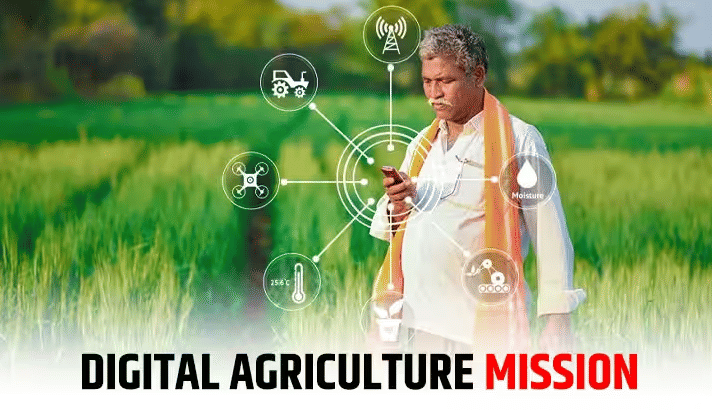Digital Agriculture Mission | Gist of Rajya Sabha TV / RSTV (now Sansad TV) - UPSC PDF Download
Digital Agriculture Mission: Transforming India's Agriculture Sector

Overview:
- On September 2, 2024, the Union Cabinet approved the Digital Agriculture Mission, allocating Rs. 2,817 crore, with Rs. 1,940 crore funded by the central government. This mission aims to revolutionize Indian agriculture by building a strong Digital Public Infrastructure (DPI) and utilizing modern technologies.
What is the Digital Agriculture Mission?
Digital Agriculture refers to using Information and Communication Technologies (ICT) and data ecosystems to deliver timely, targeted information and services, ensuring profitable and sustainable farming while providing safe, nutritious, and affordable food for all. The Digital Agriculture Mission serves as an umbrella scheme for various digital agriculture initiatives. It includes the development of DPI, the Digital General Crop Estimation Survey (DGCES), and support for IT initiatives by the Central and State Governments and academic institutions.
Mission Components:
- The mission supports various digital agriculture projects anchored on two key pillars: AgriStack and the Krishi Decision Support System (DSS). Other elements include Soil Profile Mapping and DGCES.
AgriStack (Kisan ki Pehchaan):
- Farmer Registry: Farmers will receive a digital identity (Farmer ID) linked to land, livestock, crop, and scheme details. The mission aims to create digital IDs for 11 crore farmers by FY 2026-27.
- Geo-referenced Village Maps: Digital maps connect geographic and land records, aiding land management.
- Crop Sown Registry: This tracks crops planted by farmers through mobile-based surveys, improving data accuracy.
- Pilot Projects: Pilots were conducted in six states: Uttar Pradesh, Gujarat, Maharashtra, Haryana, Punjab, and Tamil Nadu.
Krishi Decision Support System (DSS):
- This system integrates remote sensing, soil, weather, and water data to create a geospatial system for crop mapping, drought and flood monitoring, and yield assessment.
Soil Profile Mapping:
- Detailed soil profile maps will cover 142 million hectares of agricultural land. A soil profile inventory for 29 million hectares has already been completed.
Digital General Crop Estimation Survey (DGCES):
- DGCES enhances crop yield estimates using scientifically designed crop-cutting experiments, aiding in efficient schemes like MSP, crop insurance, and loans.
Additional Schemes Approved:
- Alongside the Digital Agriculture Mission, the Cabinet approved six other schemes with a total outlay of Rs. 14,235.30 crore, focusing on food security, climate resilience, livestock health, horticulture, and more.
Past Initiatives for Agricultural Digitization:
- Namo Drone Didi Scheme (2024): Drones provided to women SHGs for rental services to farmers.
- Unified Farmer Service Platform (UFSP): Integrates IT systems for seamless operation within the national agriculture ecosystem.
- Soil Health Card Scheme: Enables farmers to apply nutrients based on soil test results.
- Kisan Call Centers and Krishi Vigyan Kendras (KVKs): Provide digital and extension services to farmers.
Benefits of the Digital Agriculture Mission:
- Improved Crop Yield and Productivity: Technologies like AI, GIS, and remote sensing optimize farming practices, leading to higher yields. For instance, the Pusa Krishi initiative by ICAR-IARI demonstrates world-class agricultural innovation.
- Enhanced Decision-Making: Platforms like eNAM provide real-time market data, helping farmers make better decisions on crop management.
- Efficient Resource Management: Precision agriculture techniques ensure optimal use of water, fertilizers, and pesticides.
- Supply Chain Management: Digital platforms improve coordination between farmers, traders, and consumers, reducing post-harvest losses.
- Financial Inclusion and Crop Insurance: Digital platforms improve access to financial services and simplify the process of claiming crop insurance.
- Support for Agri-Tech Startups: Platforms like DeHaat and AgroStar empower farmers with digital tools for market access and advisory services.
- Weather Forecasting and E-Learning: Advanced tools help farmers plan better and mitigate risks, while digital platforms offer training on modern practices.
Challenges in Implementing the Digital Agriculture Mission:
- Digital Divide and Infrastructure Gaps: Many rural areas lack reliable internet and electricity, limiting access to digital technologies.
- Low Digital Literacy: Only 2% of Indian farmers use mobile apps in farming, highlighting a need for improved digital skills.
- High Initial Investment Costs: The cost of adopting digital technologies can be prohibitive for small-scale farmers, with the average landholding size in India at just 1.08 hectares.
- Integration Challenges: India’s diverse agro-climatic zones make it difficult to implement uniform digital solutions.
- Resistance to Change: Traditional farming practices may slow the adoption of modern technology.
- Data Standardization and Language Barriers: A lack of standardized agricultural data and limited vernacular content restrict access to digital services.
Way Forward:
- Improve Rural Digital Infrastructure: Accelerate the BharatNet project and encourage public-private partnerships for internet access in rural areas.
- Enhance Digital Literacy: Implement agriculture-specific digital skills training through programs like PMGDISHA.
- Develop Region-Specific Solutions: Tailor digital tools to suit India’s diverse farming practices.
- User-Friendly Multilingual Applications: Develop apps in multiple Indian languages with voice-based interfaces.
- Collaboration and Focus on Small Farmers: Encourage partnerships between tech companies and agricultural universities, and promote collective farming models for technology adoption.
- Integrate Traditional Knowledge: Use AI to incorporate traditional farming knowledge into modern digital solutions, expanding models like the Traditional Knowledge Digital Library (TKDL).
The Digital Agriculture Mission aims to modernize Indian agriculture, making it more sustainable, productive, and inclusive for the nation's farmers.
FAQs on Digital Agriculture Mission - Gist of Rajya Sabha TV / RSTV (now Sansad TV) - UPSC
| 1. What is the Digital Agriculture Mission and its objectives? |  |
| 2. How does the Digital Agriculture Mission benefit farmers in India? |  |
| 3. What role does technology play in the Digital Agriculture Mission? |  |
| 4. How does the Digital Agriculture Mission align with India's broader agricultural policies? |  |
| 5. What are the challenges faced in implementing the Digital Agriculture Mission? |  |





















